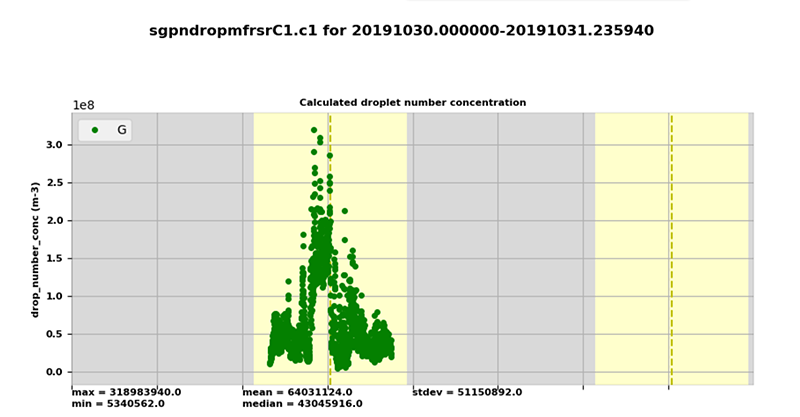Cloud Droplet Number Concentration Product Updated
Published: 24 September 2021

New data are available from the Droplet Number Concentration value-added product (NDROP VAP), which has been updated to use additional inputs. This will allow NDROP to be available quicker with better retrievals and to be applied to more sites and more cloudy days.
Cloud droplet number concentration is an important factor in understanding aerosol-cloud interactions. NDROP provides an estimate of cloud droplet number concentration for overcast liquid water clouds retrieved using cloud optical depth from the Atmospheric Radiation Measurement (ARM) user facility’s multifilter rotating shadowband radiometers (MFRSRs) and liquid water path from ARM’s microwave radiometers (MWRs).
When cloud-layer information is available from vertically pointing lidar and radar in the Active Remote Sensing of CLouds (ARSCL) VAP, NDROP also provides estimates of the adiabatic liquid water path, calculated assuming the cloud is formed by adiabatic cooling, and an adiabatic parameter that indicates how divergent the liquid water path is from the adiabatic case.
NDROP can now accept the following VAPs as inputs:
- Interpolated Sonde (INTERPSONDE)
- Ka-Band ARM Zenith Radar Active Remote Sensing of CLouds (KAZRARSCL)
- Cloud Optical Properties from the MFRSR (MFRSRCLDOD) using the Min algorithm
- Microwave Radiometer Retrievals for 2-channel and 3-channel MWRs (MWRRET and MWRRETv2).
Data processed with new inputs are available for the following ARM sites/deployments and dates:
- the Southern Great Plains Central Facility near Lamont, Oklahoma, from January 5, 2011, to August 20, 2020
- SGP extended facility E13 near Lamont from January 5, 2011, to May 18, 2015
- the Eastern North Atlantic atmospheric observatory from June 1, 2014, to October 30, 2019
- the 2016–2017 Layered Atlantic Smoke Interactions with Clouds (LASIC) field campaign on Ascension Island in the South Atlantic Ocean.
NDROP data are available in netCDF format.
Scientists can begin using droplet number concentration data from the updated VAP now. The VAP will run as inputs become available in near-real time.
More information about NDROP can be found on the VAP web page.
For questions or to report data problems, please contact ARM translator Damao Zhang or developer Chitra Sivaraman.
Access the NDROP data in the ARM Data Center. (Go here to create an account to download the data.)
To cite the data, please use doi:10.5439/1131339.
Keep up with the Atmospheric Observer
Updates on ARM news, events, and opportunities delivered to your inbox
ARM User Profile
ARM welcomes users from all institutions and nations. A free ARM user account is needed to access ARM data.


















